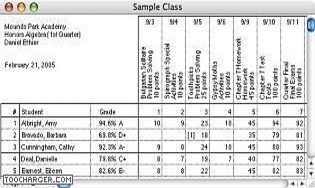
# print each student's grade as a % of the high grade for each assignmentįor student, grades in student_grades. # determine the max grade for each assignment Print(highest_so_far.name, ':', highest_so_far.grade)įor assignment, grades in assignment_ems(): Print('Student with Highest average points:') # show the student with the highest average

Highest_so_far = Grade(grade=percent, name=student) # "transpose" the student_grades dict to an assignment_grades dictįor i, grade in enumerate(grades, start=1): Highest_so_far = Grade(grade=-1, name=None) Here's a couple of ideas which I hope might help from collections import defaultdict Also, you need to use one sweep of student_grades to determine highest. Print(student, ':', round((curve * 100), 1))īy creating a dict of assignment grades you can track averages easily. Print('Assignment', i+1, ':', score / len(grades))

Print('Student with Highest total points:') Print the name and grade percentage of the student with the highest total of points.įind the average score of each assignment.įind and apply a curve to each student's total score, such that the best student has 100% of the total points.įor student, grades in student_ems(): What’s the difference between Canvas, Classtime, Gradekeeper, and SchoolCues Compare Canvas vs. Write a program that uses the keys(), values(), and/or items() dict methods to find statistics about the student_grades dictionary. Verify that there are no Gradebook columns displaying an eye with slash icon for grades that are meant to be included in the final course grade.I'm trying to figure out why my for loop is iterating over the first item in my dictionary instead of through the first index of each list in the dictionary: However, by default, assignment grades have been hidden until you release them so post any unposted grades and unhide any hidden grades before proceeding to the last step. If you have a post policy that releases grades immediately, this is no problem. It’s powerful for grading, allowing teachers to excuse kids from assignments, enter grades in a variety of ways (letter, percent, etc.), drop lowest scores and even curve an assignment’s grading. The final grade is based on posted grades only.
#GRADEKEEPER CURVE GRADES INSTALL#
If you decide to do this, it is important that you deal with missing or late assignments as described below or students may have an inflated sense of their grade trajectory. Download Gradekeeper If you already have a license, you can use the Gradekeeper web app or download and install any new release of the Windows app at no additional cost. By default, the “Hide totals in student grades summary” option is checked under Settings > Course Details > More Options, but if you uncheck it, they will see their current course total score and grade based on graded assignments.

However, an alternative to manually assigning points based on their worth is to use Assignment Groups and weighting. Some instructors assign specific points for assignments to determine the equivalent to their contribution toward the overall course grade. How can I curve an assignment You can curve an assignment by changing its points possible. Below are some tasks that can be accomplished in Canvas.
#GRADEKEEPER CURVE GRADES MANUAL#
However, it’s possible to do many basic grade calculations inside the Canvas Gradebook, freeing instructors from manual work.

Some instructors choose to calculate final grades outside of Canvas for various reasons, such as to curve final course grades, as Canvas can only curve assignment grades. The Gradebook in Canvas records points for each assignment and instructors decide how those points are calculated to become the overall course grade.


 0 kommentar(er)
0 kommentar(er)
